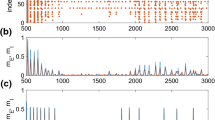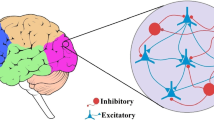Abstract
A mathematical model for describing dynamic phenomena in the olfactory bulb is presented. The nature of attractors and the bifurcation sequences in terms of the lateral connection strength in the mitral layer are studied numerically. Chaotic activity has only been found in the case of strong excitatory coupling. Synaptic modification-induced transition from oscillation to chaos is demonstrated. A model for a simple associative memory is also presented.
Similar content being viewed by others
References
Adrian ED (1950) The electrical activity of the mammalian olfactory bulb. Electroencephalogr Clin Neurophysiol 2:377–388
Ambros-Ingerson L, Granger R, Lynch G (1990) Simulation of paleocortex performs hierarchical clustering. Science 247:1344–1348
Baird B (1986) Non-linear dynamics of pattern formation and pattern recognition in the rabbit olfactory bulb. Physica 22D:150–179
Baird B (1990) Bifurcation and category learning in network models of oscillating cortex. Physica 42D:365–384
Barnard E (1989) Analysis of the Lynch-Granger model for olfactory cortex. Biol Cybern 62:151–155
Brennan P, Keverne EB (1989) Impairment of olfactory memory by local infusions of non-selective excitatory amino acid receptor antagonists into the accessory olfactory bulb. Neuroscience 33:463–468
Brennan P, Kaba H, Keverne EB (1990) Olfactory recognition: a simple memory system. Science 250:1223–1226
Borisyuk RM, Kirillov AB (1992) Bifurcation analysis of a neural network model. Biol Cybern 66:319–325
Bressler SL (1987a) Relation of olfactory bulb and cortex. I. Spatial variation of bulbo-cortical interdependence. Brain Res 409:285–293
Bressler SL (1987b) Relation of olfactory bulb and cortex. II. Model for driving of cortex by bulb. Brain Res 409:294–301
Érdi P, Grőbler T, Kaski K (1992) Dynamic phenomena in the olfactory bulb. I. Bifurcation sequences, coexistence of periodicity and chaos, synaptic modification induced transitions. In: Aleksander I, Taylor J (eds) Artificial neural networks 2. North-Holland, Amsterdam, pp 873–876
Freeman WJ (1975) Mass action in the nervous system. Academic Press, New York
Freeman WJ (1978) Spatial properties of an EEG event in the olfactory bulb and cortex. Electroencephalogr Clin Neurophysiol 44:585–605
Freeman WJ (1979) Nonlinear gain mediating cortical stimulus-response relations. Biol Cybern 33:237–247
Freeman WJ, Schneider W (1982) Changes in spatial patterns of rabbit olfactory EEG with conditioning to odours. Psychophysiology 19:44–56
Freeman WJ, Skarda C (1985) Spatial EEG patterns, non-linear dynamics and perception: the neo-Sherringtonian view. Brain Res Rev 10:147–175
Frouzakis CE, Adomaltis RA, Kevrekidis IG (1991) Resonance phenomena in an adaptively controlled system. Int J Bifurcation Chaos 1:83
Granger R, Ambros-Ingerson J, Lynch G (1989) Derivation of encoding characteristics of layer II cerebral cortex. J Cog Neurosci 1:61–87
Grőbler T, Érdi P, Kaski K (1992) Dynamic phenomena in the olfactory bulb. II. Model for a simple associative memory. In: Aleksander I, Taylor J (eds) Artificial neural networks 2. North-Holland, pp 877–880
Halász N (1990) The vertebrate olfactory system. Akadémiai Kiadó, Budapest
Hebb DO (1949) The organization of behaviour. Wiley, New York
Holley A (1991) Neural coding of olfactory information. In: Getchell TV et al (eds) Smell and taste in health and disease. Raven Press, New York, pp 329–343
Hopfield JJ (1991) Olfactory computation and object perception. Proc Natl Acad Sci USA 88:6462–6466
Hudson R, Distel H (1987) Regional autonomy in the peripheral processing of odour signals in newborn rabbits. Brain Res 421:85–94
Hudson R, Distel H, Zippel P (1990) Perceptual performance in peripherically reduced olfactory systems. In: Schild D (eds) Chemosensory information processing. Springer, Berlin Heidelberg New York, pp 259–279
Keener (1981) Infinite period bifurcation and global bifurcation branches. SIAM J Appl Math 41:127–144
Li Z (1990) A model of olfactory adaptation and sensitivity enhancement in the olfactory bulb. Biol Cybern 62:349–361
Li Z, Hopfield JJ (1989) Modelling the olfactory bulb and its neural oscillatory processings. Biol Cybern 61:379–392
Liljenström H (1991) Modelling the dynamics of olfactory cortex using simplified network units and realistic architecture. Int J Neural Systems 2:1–15
Riedel H, Schild D (1992) The dynamics of Hebbian synapses can be stabilized by a nonlinear decay term. Neural Networks 5:454–463
Schild D (1988) Principles of odour coding and a neural network for odour discrimination. Biophys J 54:1001–1011
Schild D (1990) Chemosensory information processing. (NATA ASI Series vol H 39) Springer, Berlin Heidelberg New York
Schild D, Riedel H (1992) The significance of glomerular compartmentalization for olfactory coding. Biophys J 61:704–715
Scott JW (1991) Central processing of olfaction. J Steroid Biochem Biol 39:593–600
Scott JW, Harrison TA (1987) The olfactory bulb: anatomy and physiology. In: Finger TE, Silver WL (eds) Neurobiology of taste and smell. Wiley, New York
Shepherd GM, Greer CA (1990) Olfactory bulb. In: Shepherd GM (eds) The synaptic organization of the brain. Oxford University Press, New York, pp 133–169
Skarda C, Freeman WJ (1987) How brains make chaos in order to make sense of the world. Behav Brain Sci 10:161–195
Taylor JG, Keverne BE (1991) Accessory olfactory learning. Biol Cybern 64:301–305
Trombley PO, Shepherd GM (1991) Norepinephrine inhibits mitral ell evoked EPSPs in mammalian olfactory bulb granule cells in culture. Soc Neurosci Abstr 17:103–12
Willey TJ (1973) The ultrastructure of the cat olfactory bulb. J Comp Neurol 152:211–232
Wilson MA, Bower JM (1992) Cortical oscillations and temporal interactions in a computer simulation of piriform cortex. J Neurophysiol 67:981–995
Yao Y, Freeman WJ (1990) Model of biological pattern recognition with spatially chaotic dynamics. Neural Networks 3:153–170
Author information
Authors and Affiliations
Rights and permissions
About this article
Cite this article
Érdi, P., Grőbler, T., Barna, G. et al. Dynamics of the olfactory bulb: bifurcations, learning, and memory. Biol. Cybern. 69, 57–66 (1993). https://doi.org/10.1007/BF00201408
Received:
Accepted:
Issue Date:
DOI: https://doi.org/10.1007/BF00201408




